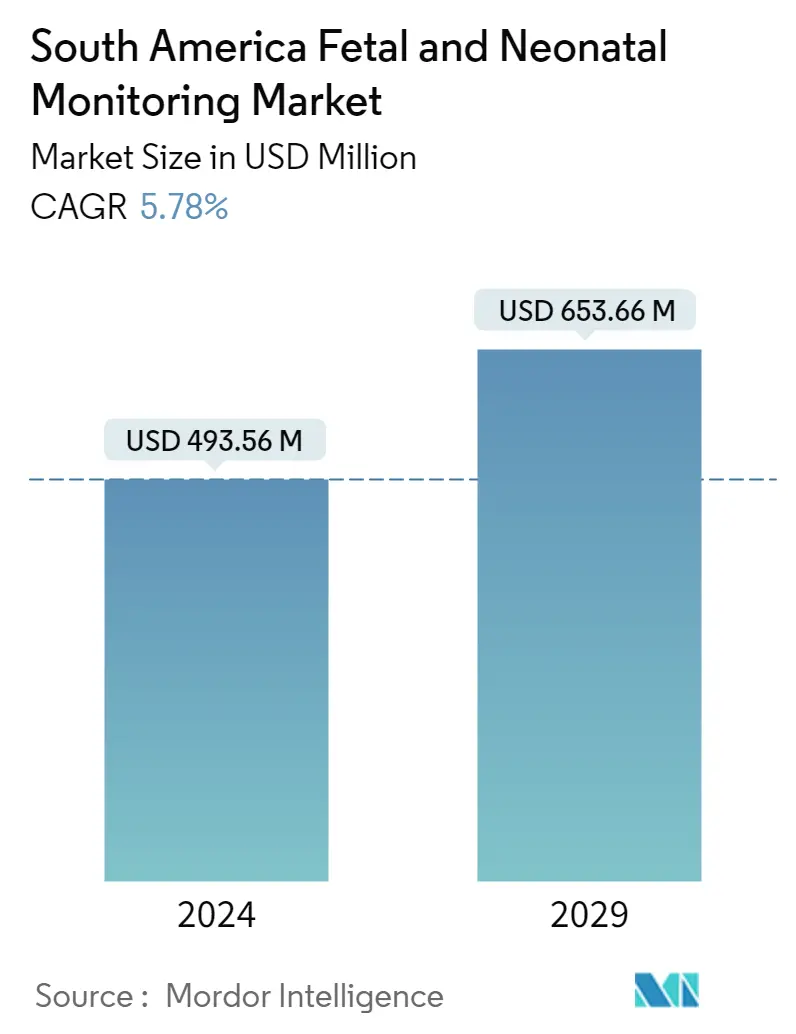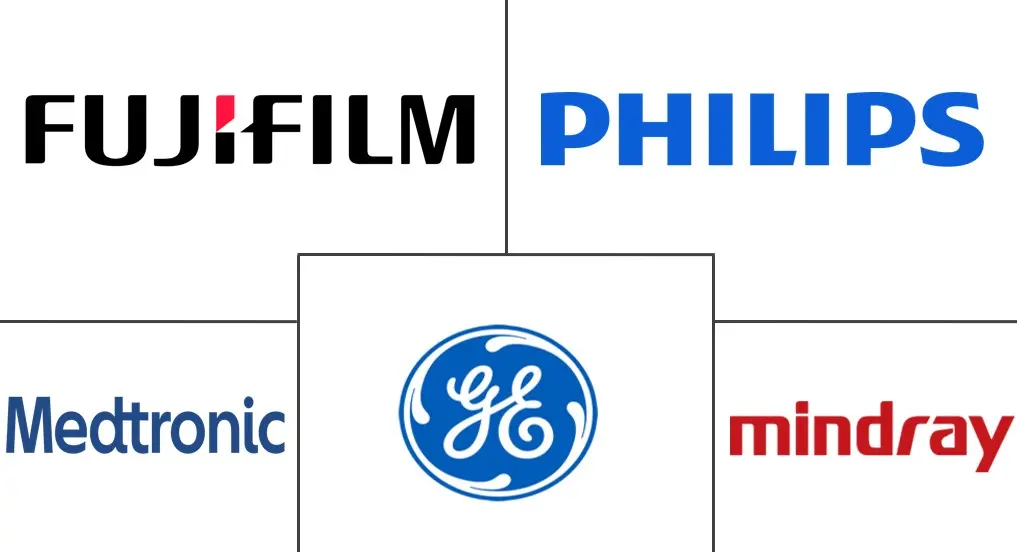Market Size of South America Fetal & Neonatal Monitoring Industry

| Study Period | 2019 - 2029 |
| Base Year For Estimation | 2023 |
| Market Size (2024) | USD 493.56 Million |
| Market Size (2029) | USD 653.66 Million |
| CAGR (2024 - 2029) | 5.78 % |
| Market Concentration | Low |
Major Players
*Disclaimer: Major Players sorted in no particular order |
South America Fetal and Neonatal Monitoring Market Analysis
The South America Fetal & Neonatal Monitoring Market size is estimated at USD 493.56 million in 2024, and is expected to reach USD 653.66 million by 2029, growing at a CAGR of 5.78% during the forecast period (2024-2029).
The COVID-19 pandemic has had a significant impact on the fetal and neonatal monitoring market. Since the beginning of the pandemic, there have been a significant number of deaths, and from the beginning of 2020 to the first few months of 2021, Brazil ranked among the top countries in the world for COVID-19 cases and fatalities. There was a decline in the birth rate in Brazil during the COVID-19 pandemic. For instance, as per the report titled "Rapid changes in birth counts in Brazilian major cities during the COVID-19 pandemic" published by Vienna Yearbook of Population Research 2022, there was a strong decline in the number of births in some of the cities of Brazil and most reductions were observed in the women aged around 30 years. Also, according to the same above-mentioned source, the decreasing trend in birth counts has slowed down in the cities of Rio de Janeiro and Belo Horizonte in 2022. Due to the uncertainty surrounding the pandemic, women have postponed and realized their fertility intentions. Thus the COVID-19 has a negative impact on the fetal & neonatal monitoring market as the birth rate has declined during the pandemic.
The South America fetal & neonatal monitoring market growth is attributed to the growing birth rate, preterm births, increasing cesarean sections, and increased complications during childbirth. Fetal & neonatal monitoring is important in delivering life-sustaining, non-invasive, and developmentally supportive care to neonates and in providing a quiet and serene environment to protect the development of the fetus. Thus, there is a great demand for these products at a low cost or locally manufactured products with safety as the main criterion. For instance, according to the Organization for Economic Cooperation and Development (OECD) Health stats, the infant mortality with no minimum threshold of gestation period or birthweight in Colombia for 2020 and 2021 were reported as 16.8 and 16.5 per 1000 live births respectively. The significant cases of infant mortality can be decreased with proper monitoring devices after birth. Hence the demand for fetal and neonatal monitoring devices may increase and drive the market growth during the study period.
However, the limited accessibility and stringent regulatory procedures are restarining the growth of market during the study period.
South America Fetal and Neonatal Monitoring Industry Segmentation
As per the scope of the report, fetal & neonatal monitoring devices and equipment are used to assess fetal heart rate and contractions of the uterus during pregnancy and childbirth. The South America fetal & neonatal monitoring market is segmented by Product Type (Fetal Monitoring Devices [Heart Rate Monitors, Uterine Contraction monitors, Pulse Oximeters, and Other Fetal Monitoring Devices] and Neonatal Monitoring Devices [Cardiac Monitors, Capnographs, Blood Pressure Monitors, Pulse Oximeters and Other Neonatal Monitoring Devices]), End User (Hospitals, Neonatal Care Centers, and Other End Users), and Geography (Brazil, Argentina, and Rest of South America). The report offers the value (in USD million) for the above segments.
| By Product Type | |||||||
| |||||||
|
| By End User | |
| Hospitals | |
| Neonatal Care Centers | |
| Other End Users |
| Geography | |
| Brazil | |
| Argentina | |
| Rest of South America |
South America Fetal & Neonatal Monitoring Market Size Summary
The South America fetal and neonatal monitoring market is poised for growth, driven by factors such as an increasing birth rate, a rise in preterm births, and a higher incidence of cesarean sections. The market is characterized by the demand for life-sustaining and developmentally supportive care for neonates, which underscores the importance of fetal and neonatal monitoring devices. These devices are crucial in providing a serene environment for fetal development and in reducing infant mortality rates through effective post-birth monitoring. Despite the challenges posed by the COVID-19 pandemic, which led to a temporary decline in birth rates in countries like Brazil, the market is expected to expand due to the ongoing need for monitoring solutions that ensure the health and safety of both mothers and infants.
Brazil is anticipated to lead the market due to its well-structured healthcare system and the significant burden of preterm births and neonatal mortality. The region's market is moderately competitive, with global players dominating the landscape. These companies are leveraging their extensive distribution networks and research capabilities to maintain a strong presence. Collaborations and acquisitions, such as those between Rockley Photonics and Medtronic, and Royal Philips and Cardiologs, are indicative of the strategic moves being made to enhance product offerings and market reach. The demand for affordable and locally manufactured monitoring devices, coupled with the need for continuous monitoring in neonatal intensive care units, is expected to drive market growth during the forecast period.
South America Fetal & Neonatal Monitoring Market Size - Table of Contents
-
1. MARKET DYNAMICS
-
1.1 Market Overview
-
1.2 Market Drivers
-
1.2.1 Increasing Number of Preterm and Low-weight Births
-
1.2.2 Increasing Birth Rate and Growing Government Initiatives Regarding Fetal Care
-
-
1.3 Market Restraints
-
1.3.1 Limited Accessibility and Stringent Regulatory Procedures
-
-
1.4 Porter's Five Force Analysis
-
1.4.1 Threat of New Entrants
-
1.4.2 Bargaining Power of Buyers/Consumers
-
1.4.3 Bargaining Power of Suppliers
-
1.4.4 Threat of Substitute Products
-
1.4.5 Intensity of Competitive Rivalry
-
-
-
2. MARKET SEGMENTATION (Market Size by Value - USD million)
-
2.1 By Product Type
-
2.1.1 Fetal Monitoring Devices
-
2.1.1.1 Heart Rate Monitors
-
2.1.1.2 Uterine Contraction Monitors
-
2.1.1.3 Pulse Oximeters
-
2.1.1.4 Other Fetal Monitoring Devices
-
-
2.1.2 Neonatal Monitoring Devices
-
2.1.2.1 Cardiac Monitors
-
2.1.2.2 Capnographs
-
2.1.2.3 Blood Pressure Monitors
-
2.1.2.4 Pulse Oximeters
-
2.1.2.5 Other Neonatal Monitoring Devices
-
-
-
2.2 By End User
-
2.2.1 Hospitals
-
2.2.2 Neonatal Care Centers
-
2.2.3 Other End Users
-
-
2.3 Geography
-
2.3.1 Brazil
-
2.3.2 Argentina
-
2.3.3 Rest of South America
-
-
South America Fetal & Neonatal Monitoring Market Size FAQs
How big is the South America Fetal & Neonatal Monitoring Market?
The South America Fetal & Neonatal Monitoring Market size is expected to reach USD 493.56 million in 2024 and grow at a CAGR of 5.78% to reach USD 653.66 million by 2029.
What is the current South America Fetal & Neonatal Monitoring Market size?
In 2024, the South America Fetal & Neonatal Monitoring Market size is expected to reach USD 493.56 million.

